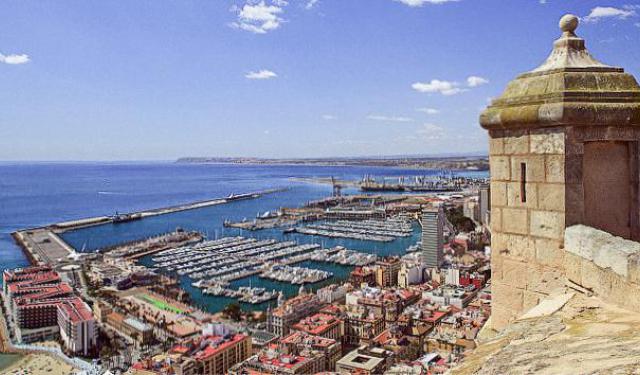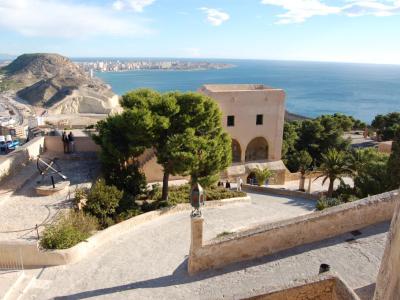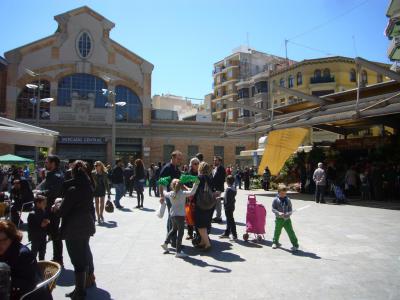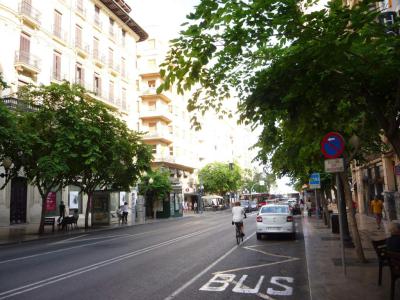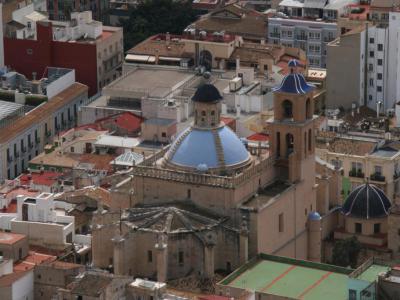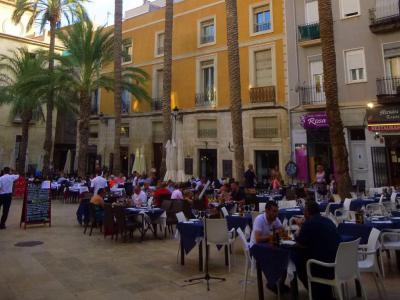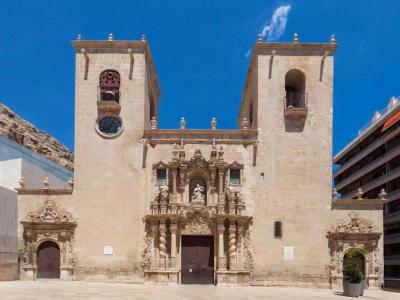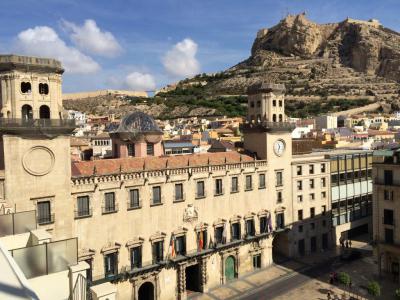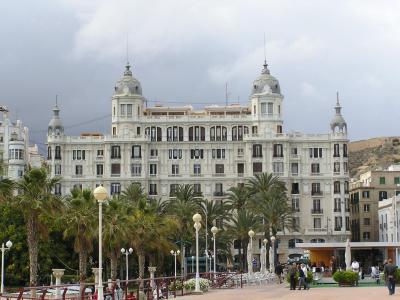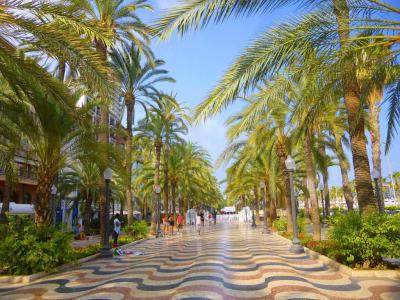Alicante Introduction Walking Tour (Self Guided), Alicante
A coastal gem on the eastern shores of Spain, where the sun kisses the sea and the turquoise Mediterranean waters gently lap against the sandy shores, the city of Alicante is an ideal combination of leisure activities and cultural attractions.
The Alicante region boasts a fascinating history spanning over 7,000 years. Early settlements on the slopes of Mount Benacantil emerged between 5000 and 3000 BC. By 1000 BC, Greek and Phoenician traders established here small ports, introducing the native Iberian tribes to the alphabet and new technologies.
The name “Alicante” is believed to have originated from the Arabic "Al-Laqant," which derived from the Latin Lucentum and Greek Leuké, meaning "white." In the mid-230s BC, Carthaginian general Hamilcar Barca established the fortified settlement of Akra Leuké (which means "White Mountain") thus setting the foundation for the future city.
In the centuries that followed, Alicante experienced Roman rule for over 700 years, Visigothic influence, and eventually Arab conquest in the 8th century. The city flourished as a Mediterranean trading hub, exporting goods like rice, wine, and oranges. The Moors' reign lasted until the 13th-century Reconquest. In the 17th century, the expulsion of Muslims from the area and subsequent wars led to an economic decline.
The 18th century marked a slow recovery through industries like shoemaking and agriculture. The 20th century saw the city benefit from Spain's neutrality in World War I and later witnessed political upheaval and the Spanish Civil War.
In the late 1950s and 1960s, the tourism industry transformed Alicante with the development of high-rise hotels near the harbor and infrastructure. Today, the Port of Alicante thrives as a cruise destination, contributing to the city's rejuvenation.
Throughout the city, lush gardens and elegant palm-fringed boulevards break up the urban sprawl. One such is the Spanish Promenade (Explanada de España) whose colorful mosaic tiles and palm trees create a delightful atmosphere for a leisurely stroll along the waterfront.
One of Alicante's most iconic landmarks is Santa Bárbara Castle, perched high on Mount Benacantil. This imposing fortress is a must-visit site for history enthusiasts and those seeking a memorable vantage point.
Alicante's Central Market, situated in the heart of the city, is a culinary haven where locals and visitors regularly rub shoulders exploring a variety of fresh produce, seafood, meats, and other regional delicacies.
Over the years, this popular resort on the Costa Blanca has had its share of admirers. It may well be that you will become one of them. Take this self-guided walk and see if you can share the sentiment of numerous travelers who have fallen in love with Alicante's charm.
The Alicante region boasts a fascinating history spanning over 7,000 years. Early settlements on the slopes of Mount Benacantil emerged between 5000 and 3000 BC. By 1000 BC, Greek and Phoenician traders established here small ports, introducing the native Iberian tribes to the alphabet and new technologies.
The name “Alicante” is believed to have originated from the Arabic "Al-Laqant," which derived from the Latin Lucentum and Greek Leuké, meaning "white." In the mid-230s BC, Carthaginian general Hamilcar Barca established the fortified settlement of Akra Leuké (which means "White Mountain") thus setting the foundation for the future city.
In the centuries that followed, Alicante experienced Roman rule for over 700 years, Visigothic influence, and eventually Arab conquest in the 8th century. The city flourished as a Mediterranean trading hub, exporting goods like rice, wine, and oranges. The Moors' reign lasted until the 13th-century Reconquest. In the 17th century, the expulsion of Muslims from the area and subsequent wars led to an economic decline.
The 18th century marked a slow recovery through industries like shoemaking and agriculture. The 20th century saw the city benefit from Spain's neutrality in World War I and later witnessed political upheaval and the Spanish Civil War.
In the late 1950s and 1960s, the tourism industry transformed Alicante with the development of high-rise hotels near the harbor and infrastructure. Today, the Port of Alicante thrives as a cruise destination, contributing to the city's rejuvenation.
Throughout the city, lush gardens and elegant palm-fringed boulevards break up the urban sprawl. One such is the Spanish Promenade (Explanada de España) whose colorful mosaic tiles and palm trees create a delightful atmosphere for a leisurely stroll along the waterfront.
One of Alicante's most iconic landmarks is Santa Bárbara Castle, perched high on Mount Benacantil. This imposing fortress is a must-visit site for history enthusiasts and those seeking a memorable vantage point.
Alicante's Central Market, situated in the heart of the city, is a culinary haven where locals and visitors regularly rub shoulders exploring a variety of fresh produce, seafood, meats, and other regional delicacies.
Over the years, this popular resort on the Costa Blanca has had its share of admirers. It may well be that you will become one of them. Take this self-guided walk and see if you can share the sentiment of numerous travelers who have fallen in love with Alicante's charm.
How it works: Download the app "GPSmyCity: Walks in 1K+ Cities" from Apple App Store or Google Play Store to your mobile phone or tablet. The app turns your mobile device into a personal tour guide and its built-in GPS navigation functions guide you from one tour stop to next. The app works offline, so no data plan is needed when traveling abroad.
Alicante Introduction Walking Tour Map
Guide Name: Alicante Introduction Walking Tour
Guide Location: Spain » Alicante (See other walking tours in Alicante)
Guide Type: Self-guided Walking Tour (Sightseeing)
# of Attractions: 9
Tour Duration: 2 Hour(s)
Travel Distance: 2.9 Km or 1.8 Miles
Author: DanaOffice
Sight(s) Featured in This Guide:
Guide Location: Spain » Alicante (See other walking tours in Alicante)
Guide Type: Self-guided Walking Tour (Sightseeing)
# of Attractions: 9
Tour Duration: 2 Hour(s)
Travel Distance: 2.9 Km or 1.8 Miles
Author: DanaOffice
Sight(s) Featured in This Guide:
- Santa Bárbara Castle
- Alicante's Central Market
- Rambla Mendez Nunez (Mendez Nunez Avenue)
- Co-cathedral of Saint Nicholas of Bari
- Old Town and Square of the Most Holy Face
- Basilica of Santa María
- Alicante Town Hall
- Casa Carbonell (Carbonell House)
- Explanada de España (Spanish Promenade)
1) Santa Bárbara Castle (must see)
Santa Bárbara Castle's hilltop location on Monte Benacantil has made it a strategically important site since ancient times, dating back to the Carthaginian era. Its elevated position provides a commanding view of the surrounding region. The castle's origins trace back to the 9th century when it was originally an Islamic alcazar, or Moorish fortress. It played a significant role in the region's history during this period.
The castle gained its name, Santa Bárbara Castle, from a victorious battle during the Christian Reconquista when it was captured from the Moors by Prince Alfonso of Castile. This battle occurred on the feast day of Santa Barbara, which explains the castle's name. During the reign of Philip II, the castle underwent a significant renovation in the Renaissance style. This phase of its history added architectural elements and features that still stand today.
While touring the castle, you'll have the opportunity to explore various attractions, including La Torreta (the old keep or tower), the magnificent reception hall of Philip II, the Patio de Armas (courtyard), and the Revellín del Bon Repós rampart. The castle hosts themed weekends, dramatized visits, and gastronomic experiences throughout the year, allowing visitors to immerse themselves in different aspects of its history and culture.
One of the most captivating aspects of Santa Bárbara Castle is its panoramic coastal views. From the ramparts and the tower, visitors can enjoy sweeping vistas that encompass the town, the bay, and the hills to the north.
Santa Bárbara Castle is open year-round for visitors.
The castle gained its name, Santa Bárbara Castle, from a victorious battle during the Christian Reconquista when it was captured from the Moors by Prince Alfonso of Castile. This battle occurred on the feast day of Santa Barbara, which explains the castle's name. During the reign of Philip II, the castle underwent a significant renovation in the Renaissance style. This phase of its history added architectural elements and features that still stand today.
While touring the castle, you'll have the opportunity to explore various attractions, including La Torreta (the old keep or tower), the magnificent reception hall of Philip II, the Patio de Armas (courtyard), and the Revellín del Bon Repós rampart. The castle hosts themed weekends, dramatized visits, and gastronomic experiences throughout the year, allowing visitors to immerse themselves in different aspects of its history and culture.
One of the most captivating aspects of Santa Bárbara Castle is its panoramic coastal views. From the ramparts and the tower, visitors can enjoy sweeping vistas that encompass the town, the bay, and the hills to the north.
Santa Bárbara Castle is open year-round for visitors.
2) Alicante's Central Market (must see)
Alicante's Central Market, a culinary treasure trove, stands as a testament to the city's commitment to provide its residents with a vibrant marketplace for fresh produce. This bustling market, a successor to the smaller Puerta del Mar and García Calamarte markets of the 19th century.
The roots of Alicante's Central Market extend back to the late 19th century when it emerged as the solution to the city's modest and less hygienic markets. In response to the need for a modern and sanitary sales center, local authorities commissioned architects Juan Vidal Ramos and Francisco Fajardo Guardiola to bring this vision to life.
The architects envisioned a rectangular building with spacious corridors and lofty ceilings, reflecting the architectural trends of the era. The resulting structure bears elements of Modernism and eclecticism, creating a harmonious blend of aesthetics and functionality. Constructed partly from brick, it boasts a gable roof and features large stained glass windows beneath the roofline, allowing natural light to flood the interior.
One of the most distinctive features of Alicante's Central Market is the Rotonda, an architectural marvel that graces one side of the main façade. This semi-spherical roof is a striking and iconic element of the market's design, providing both structural and visual intrigue.
Spanning nearly 11,000 square meters, the market hosts nearly 300 stalls or commercial units. These stalls form a bustling mosaic of flavors and offerings. From vibrant displays of fresh fruits and vegetables to the briny allure of seafood and the savory aromas of meat, sausages, poultry, and eggs, the Central Market is a haven for food enthusiasts.
In addition to the market's stalls, there are also bars and restaurants where you can sample fresh and delicious dishes prepared with the finest market ingredients.
The roots of Alicante's Central Market extend back to the late 19th century when it emerged as the solution to the city's modest and less hygienic markets. In response to the need for a modern and sanitary sales center, local authorities commissioned architects Juan Vidal Ramos and Francisco Fajardo Guardiola to bring this vision to life.
The architects envisioned a rectangular building with spacious corridors and lofty ceilings, reflecting the architectural trends of the era. The resulting structure bears elements of Modernism and eclecticism, creating a harmonious blend of aesthetics and functionality. Constructed partly from brick, it boasts a gable roof and features large stained glass windows beneath the roofline, allowing natural light to flood the interior.
One of the most distinctive features of Alicante's Central Market is the Rotonda, an architectural marvel that graces one side of the main façade. This semi-spherical roof is a striking and iconic element of the market's design, providing both structural and visual intrigue.
Spanning nearly 11,000 square meters, the market hosts nearly 300 stalls or commercial units. These stalls form a bustling mosaic of flavors and offerings. From vibrant displays of fresh fruits and vegetables to the briny allure of seafood and the savory aromas of meat, sausages, poultry, and eggs, the Central Market is a haven for food enthusiasts.
In addition to the market's stalls, there are also bars and restaurants where you can sample fresh and delicious dishes prepared with the finest market ingredients.
3) Rambla Mendez Nunez (Mendez Nunez Avenue)
Mendez Nunez Avenue, affectionately known as La Rambla, serves as a vibrant artery in the heart of Alicante. This central avenue is not just a thoroughfare but a lively meeting point that seamlessly bridges the Centro and Casco Antiguo neighborhoods while connecting the bustling city center with the tranquil allure of the port and beach. Benches line the boulevard, inviting passersby to pause, relax, and soak in the ambience.
The boulevard derives its name from Casto Mendez Nunez, a notable 19th-century Spanish military figure. His legacy is immortalized in this scenic avenue, offering a nod to history as you traverse its length.
This beloved avenue is not just about picturesque views; it's a hub of activity. Rambla Mendez Nunez boasts a plethora of dining establishments, including restaurants, cafes, and bars. Whether you're craving local tapas, international cuisine, or simply a cup of coffee, you'll find a spot that piques your culinary curiosity. The presence of shops adds to the lively atmosphere, allowing you to indulge in a spot of retail therapy.
With its broad sidewalks, lush greenery, and inviting seating, Rambla Mendez Nunez is a delight to explore on foot. Whether you're a leisurely stroller or an avid people-watcher, the avenue caters to all. The tree-lined street provides shade and a refreshing ambiance, making it an ideal spot for a leisurely afternoon jaunt or a romantic evening stroll.
The boulevard derives its name from Casto Mendez Nunez, a notable 19th-century Spanish military figure. His legacy is immortalized in this scenic avenue, offering a nod to history as you traverse its length.
This beloved avenue is not just about picturesque views; it's a hub of activity. Rambla Mendez Nunez boasts a plethora of dining establishments, including restaurants, cafes, and bars. Whether you're craving local tapas, international cuisine, or simply a cup of coffee, you'll find a spot that piques your culinary curiosity. The presence of shops adds to the lively atmosphere, allowing you to indulge in a spot of retail therapy.
With its broad sidewalks, lush greenery, and inviting seating, Rambla Mendez Nunez is a delight to explore on foot. Whether you're a leisurely stroller or an avid people-watcher, the avenue caters to all. The tree-lined street provides shade and a refreshing ambiance, making it an ideal spot for a leisurely afternoon jaunt or a romantic evening stroll.
4) Co-cathedral of Saint Nicholas of Bari
The Co-Cathedral of Saint Nicholas of Bari stands as a testament to both architectural magnificence and spiritual devotion. Originally constructed between 1613 and 1662, this Roman Catholic co-cathedral, dedicated to Saint Nicholas, carries a rich history and a profound sense of sacredness.
The cathedral's design, conceived between 1610 and 1615 by Agustín Bernardino, a student of the renowned architect Juan de Herrera, is a testament to Spanish Baroque architecture. It was meticulously constructed upon the foundations of an ancient mosque, echoing the diverse layers of history that shape Spain.
The cathedral boasts a Latin cross plan with relatively short transepts. Alongside the nave, six interconnected side chapels and an ambulatory enveloping the apse offer spaces for reflection and devotion. Rising proudly above the crossing is a striking blue dome, soaring to a height of 45 meters, a celestial symbol of faith.
A true gem within the Co-Cathedral, the Chapel of Holy Communion stands as a masterpiece of Spanish Baroque design. Configured as a small Greek cross-planned temple, its intricate beauty and exquisite detailing make it one of the most captivating examples of this architectural style.
The cathedral's external appearance exudes an air of sobriety. The main façade, facing east, showcases the Doric order, while the south facade is adorned with the Ionic order. These elements combine to create a harmonious exterior that belies the ornate treasures held within.
On 9 March 1959, Pope John XXIII elevated this church to the prestigious status of cathedral within the Diocese of Orihuela-Alicante, signifying its spiritual importance and significance in the region.
The cathedral's design, conceived between 1610 and 1615 by Agustín Bernardino, a student of the renowned architect Juan de Herrera, is a testament to Spanish Baroque architecture. It was meticulously constructed upon the foundations of an ancient mosque, echoing the diverse layers of history that shape Spain.
The cathedral boasts a Latin cross plan with relatively short transepts. Alongside the nave, six interconnected side chapels and an ambulatory enveloping the apse offer spaces for reflection and devotion. Rising proudly above the crossing is a striking blue dome, soaring to a height of 45 meters, a celestial symbol of faith.
A true gem within the Co-Cathedral, the Chapel of Holy Communion stands as a masterpiece of Spanish Baroque design. Configured as a small Greek cross-planned temple, its intricate beauty and exquisite detailing make it one of the most captivating examples of this architectural style.
The cathedral's external appearance exudes an air of sobriety. The main façade, facing east, showcases the Doric order, while the south facade is adorned with the Ionic order. These elements combine to create a harmonious exterior that belies the ornate treasures held within.
On 9 March 1959, Pope John XXIII elevated this church to the prestigious status of cathedral within the Diocese of Orihuela-Alicante, signifying its spiritual importance and significance in the region.
5) Old Town and Square of the Most Holy Face
The Square of the Most Holy Face in Alicante, Spain, is a charming and picturesque area located in the Santa Cruz neighborhood, one of the most delightful parts of the city. Nestled between the Santa Bárbara Castle and the historic old town, this neighborhood exudes a distinct nautical atmosphere. Here, the majority of houses are adorned in white, adorned with colorful paintings, vibrant potted flowers, and decorative tiles. The residents take great pride in meticulously maintaining their neighborhood, evident in the well-kept streets and houses.
Walking through this part of Alicante's old town is akin to stepping into a traditional Andalusian village within the city itself. The ambiance is tranquil, and you'll find enchanting winding streets flanked by whitewashed buildings adorned with vibrant potted plants, and doors and window frames painted in lively colors. There's a hint of Moorish influence in the architecture, reminiscent of the charming streets of Cordoba or Granada.
The Square of the Most Holy Face, located just behind the Town Hall, is one of the most picturesque spots in Alicante. Tall palm trees surround the square, creating a pleasant and inviting atmosphere. Visitors can enjoy al fresco dining at the numerous restaurants that line the square. The square is enclosed by beautiful buildings, and notable features include a lovely fountain and a cross. It's a perfect place to relax, savor a meal or a drink, and engage in people-watching while taking in the beauty of this enchanting square.
Walking through this part of Alicante's old town is akin to stepping into a traditional Andalusian village within the city itself. The ambiance is tranquil, and you'll find enchanting winding streets flanked by whitewashed buildings adorned with vibrant potted plants, and doors and window frames painted in lively colors. There's a hint of Moorish influence in the architecture, reminiscent of the charming streets of Cordoba or Granada.
The Square of the Most Holy Face, located just behind the Town Hall, is one of the most picturesque spots in Alicante. Tall palm trees surround the square, creating a pleasant and inviting atmosphere. Visitors can enjoy al fresco dining at the numerous restaurants that line the square. The square is enclosed by beautiful buildings, and notable features include a lovely fountain and a cross. It's a perfect place to relax, savor a meal or a drink, and engage in people-watching while taking in the beauty of this enchanting square.
6) Basilica of Santa María
The Basilica of Santa María, situated in the Barrio Santa Cruz of Alicante holds the distinction of being the city's oldest church, with its origins dating back to the 14th century. This remarkable basilica has a fascinating history, as it was constructed on the site of Alicante's principal mosque from the Moorish era. During the 15th century, the Catholic Monarchs undertook significant renovations and reconstructions to transform it into the magnificent structure we see today.
Originally built in the Gothic architectural style, the basilica underwent a striking transformation in the 18th century, adopting a Baroque facade and interior that added to its architectural grandeur. When you first approach the basilica, the main front exterior captures your attention with the breathtaking sculpture of the Virgin, a masterpiece of intricate stone carving created by Juan Bautista Borja.
One of the most intriguing aspects of the Basilica of Santa María is its distinctive pair of bell towers, positioned on either side of the entrance. Interestingly, these two towers do not match in style. The first bell tower was constructed in the 14th century, while the second was not added until the 18th century.
Step inside, and you'll find yourself in a sanctuary adorned with rich decorations. Be sure to take a moment to admire the high altar, a remarkable piece of 18th-century artistry designed in the elaborate Rococo style.
Originally built in the Gothic architectural style, the basilica underwent a striking transformation in the 18th century, adopting a Baroque facade and interior that added to its architectural grandeur. When you first approach the basilica, the main front exterior captures your attention with the breathtaking sculpture of the Virgin, a masterpiece of intricate stone carving created by Juan Bautista Borja.
One of the most intriguing aspects of the Basilica of Santa María is its distinctive pair of bell towers, positioned on either side of the entrance. Interestingly, these two towers do not match in style. The first bell tower was constructed in the 14th century, while the second was not added until the 18th century.
Step inside, and you'll find yourself in a sanctuary adorned with rich decorations. Be sure to take a moment to admire the high altar, a remarkable piece of 18th-century artistry designed in the elaborate Rococo style.
7) Alicante Town Hall
The Alicante Town Hall -eighteenth-century baroque masterpiece, designed by the acclaimed architect Lorenzo Chápuli, is a magnificent testament to the city's rich history and architectural grandeur.
The Town Hall, originally constructed on the site of the former City Hall, is a masterpiece of eighteenth-century baroque civil architecture. Its main façade is a captivating blend of intricate details and elegant design elements. Solomonic columns grace the entrance, setting the tone for the ornate splendor that awaits within. Two majestic towers frame the structure, adding to its regal presence.
As you step inside, a grand red marble staircase welcomes you. Ascending these elegant steps, you'll find yourself in the Blue Room, a stunning example of Isabelline style. The top floor houses the Plenary Room, where important civic matters are deliberated upon, and a chapel that provides a serene space for masses.
The Town Hall boasts a minimalist annex building, a harmonious contrast to the baroque opulence of the main structure. Here, a remarkable surprise awaits-a glimpse into the medieval city of Alicante. The ground floor showcases archaeological remains that transport you back in time to the city's medieval origins. The structure itself is a testament to modern engineering, crafted from cement and iron, visible both inside and out.
To top off this architectural marvel, the annex building's top floor unveils an avant-garde glazed terrace. From this vantage point, you'll be treated to breathtaking views of Santa Barbara Castle, an enduring symbol of Alicante's heritage.
The Town Hall, originally constructed on the site of the former City Hall, is a masterpiece of eighteenth-century baroque civil architecture. Its main façade is a captivating blend of intricate details and elegant design elements. Solomonic columns grace the entrance, setting the tone for the ornate splendor that awaits within. Two majestic towers frame the structure, adding to its regal presence.
As you step inside, a grand red marble staircase welcomes you. Ascending these elegant steps, you'll find yourself in the Blue Room, a stunning example of Isabelline style. The top floor houses the Plenary Room, where important civic matters are deliberated upon, and a chapel that provides a serene space for masses.
The Town Hall boasts a minimalist annex building, a harmonious contrast to the baroque opulence of the main structure. Here, a remarkable surprise awaits-a glimpse into the medieval city of Alicante. The ground floor showcases archaeological remains that transport you back in time to the city's medieval origins. The structure itself is a testament to modern engineering, crafted from cement and iron, visible both inside and out.
To top off this architectural marvel, the annex building's top floor unveils an avant-garde glazed terrace. From this vantage point, you'll be treated to breathtaking views of Santa Barbara Castle, an enduring symbol of Alicante's heritage.
8) Casa Carbonell (Carbonell House)
The Carbonell House, a residential masterpiece, which dates back to 1925, is a remarkable fusion of historicist architectural elements and Valencian modernism, and its story is as captivating as its design.
The Carbonell House was the brainchild of the talented Alicante architect, Juan Vidal Ramos. Its creation was a true labor of love, showcasing the architect's commitment to merging classical and modern design principles into a harmonious whole.
The house was commissioned by Enrique Carbonell, a textile magnate from Alcoy who amassed his fortune during the tumultuous years of the First World War. Eager to savor extended stays in the vibrant city of Alicante, he envisioned a residence that would be a testament to his success and a testament to architectural beauty.
In the construction of Carbonell House, no expense was spared. Noble materials such as marble for the hallways, sandstone for the plinth, iron and glass for canopies and locksmiths, and simulated slate for the roof were meticulously selected.
The façade of Carbonell House adheres to academic conventions, with a tripartite division of its parts, symmetry, and a clear hierarchy of design elements. The classic French-style ornamentation adds a touch of opulence, creating a sense of timelessness and grandeur.
A Place of Contemporary Use: While Carbonell House retains its historical charm, it has adapted to contemporary needs. Today, the ground floor and mezzanine house commercial premises and offices, while the upper floors provide rental housing.
The Carbonell House was the brainchild of the talented Alicante architect, Juan Vidal Ramos. Its creation was a true labor of love, showcasing the architect's commitment to merging classical and modern design principles into a harmonious whole.
The house was commissioned by Enrique Carbonell, a textile magnate from Alcoy who amassed his fortune during the tumultuous years of the First World War. Eager to savor extended stays in the vibrant city of Alicante, he envisioned a residence that would be a testament to his success and a testament to architectural beauty.
In the construction of Carbonell House, no expense was spared. Noble materials such as marble for the hallways, sandstone for the plinth, iron and glass for canopies and locksmiths, and simulated slate for the roof were meticulously selected.
The façade of Carbonell House adheres to academic conventions, with a tripartite division of its parts, symmetry, and a clear hierarchy of design elements. The classic French-style ornamentation adds a touch of opulence, creating a sense of timelessness and grandeur.
A Place of Contemporary Use: While Carbonell House retains its historical charm, it has adapted to contemporary needs. Today, the ground floor and mezzanine house commercial premises and offices, while the upper floors provide rental housing.
9) Explanada de España (Spanish Promenade) (must see)
Explanada de España is a magnificent promenade offering a delightful introduction to this coastal city. Running parallel to the seaside, it extends from Alicante Port in the east to Canalejas Park in the west.
Explanada de España treats visitors to panoramic views of Alicante's marina, where elegant yachts and colorful fishing boats bob gently in the waters. The promenade's location along the seafront provides a captivating backdrop for your exploration.
As you meander along the promenade, you'll encounter several noteworthy landmarks and architectural gems. Casa Carbonell, an iconic building, and the Royal Casino de Alicante, a prestigious establishment, grace the promenade with their presence. The elegant Hotel Gran Sol also stands proudly along this picturesque stretch.
Explanada Promenade is the ideal location for leisurely walks and casual strolls. Its surface features beautifully laid small marble stones, creating a visually appealing pavement for visitors to tread upon. Tall palm trees provide welcome shade, enhancing the pleasant atmosphere.
The promenade is dotted with charming cafés, bars, and restaurants, offering enticing culinary experiences. You can savor local fish and seafood dishes while enjoying the refreshing sea breeze. Alternatively, you can take in the stunning views with a cup of coffee at one of the inviting establishments. For those interested in taking home a piece of Alicante, small stalls along the promenade offer a variety of souvenirs and local crafts. It's an excellent opportunity to find unique keepsakes and gifts to remember your visit.
Explanada de España treats visitors to panoramic views of Alicante's marina, where elegant yachts and colorful fishing boats bob gently in the waters. The promenade's location along the seafront provides a captivating backdrop for your exploration.
As you meander along the promenade, you'll encounter several noteworthy landmarks and architectural gems. Casa Carbonell, an iconic building, and the Royal Casino de Alicante, a prestigious establishment, grace the promenade with their presence. The elegant Hotel Gran Sol also stands proudly along this picturesque stretch.
Explanada Promenade is the ideal location for leisurely walks and casual strolls. Its surface features beautifully laid small marble stones, creating a visually appealing pavement for visitors to tread upon. Tall palm trees provide welcome shade, enhancing the pleasant atmosphere.
The promenade is dotted with charming cafés, bars, and restaurants, offering enticing culinary experiences. You can savor local fish and seafood dishes while enjoying the refreshing sea breeze. Alternatively, you can take in the stunning views with a cup of coffee at one of the inviting establishments. For those interested in taking home a piece of Alicante, small stalls along the promenade offer a variety of souvenirs and local crafts. It's an excellent opportunity to find unique keepsakes and gifts to remember your visit.
The Most Popular Cities
/ view all
